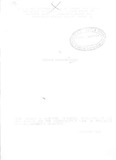| dc.description.abstract | The study of infant and child mortality is considered to he important in that it is a sensitive index as a measure of the status of health and provision of other basic facilities and the standard of living of a given area. According to Kenyan Demographic and Health Survey (1989), infant mortality rate for Nairobi was estimated to be 46/1000 live births. But this relatively low estimate of infant mortality masks an important differential in mortality in the different wards that make up Nairobi.
This study endeavoured to look at infant and child mortality differentials in Nairobi by different background variables (maternal education, marital status and migration status). The wards taken into consideration are Mathare Valley, Harambe- Lumumba and Parklands-Spring Valley representing low status, medium status and high status wards. The 1979 Kenyan population census data was utilised from which data on children ever born and children dead reported by women in reproductive ages by five year age group was derived. This was done by the different background variables considered.
Trussell's indirect technique for the estimation of child
I-"*! 1 I 1 T T "1 I ~i ITSl
mortality was used as a metnoaoxogy ot aata analyses. me
probabilities of dy-if»
at age
x, q< ) , estimates thus obtained
were finally utilised to construct life tables for the wards considered from which infant and child mortality estimates iq0 and 4qi respectively - were derived by different background variables. The other important measure of mortality derived from the life tables is life expectancy at birth denoted by e0.
The study arrived at the following findings even though these findings are not different from what earlier studies have
established.
Level
o
f maternal education
'ound to
Q€
inversely associated with infant and child mortality in all the wards considered. The association of marital status and infant
mortality does not show’ a clear and
consi
Lb U © li L>
pattern
for all the wards considered. For Mathare Valley and Harambe-
v
Lumumba, married women registered the lowest iq0 and 4qi and the highest eo estimates followed by the single counterparts. The widowed/divorced/separated registered the highest iq0 and 4qi and the lowest eo estimates. The results for Parklands-Spring Valley are slightly different where the widowed/separated/'d ivorced mothers have an advantage over the single counterparts. infant and child mortality varies significantly with migration status of the mother. Mothers born outside Nairobi experienced higher infant and child mortality for the wards considered except Harambe-Lumumba which registered a higher infant and child mortality estimate for mothers born in Nairobi over mothers born outside Nairobi.
The above findings prompted some recommendations for policy making among which are to enhance the general level of education of the female population, to orientate employment generating programmes for women towards the widowed/separated/divorced counterparts so as to enable them enhance their ability to provide adequate child care and to give a special attention to migrant mothers and their children in the provision of healtn and other basic services.
vi | |

